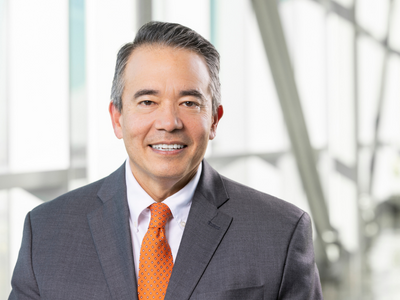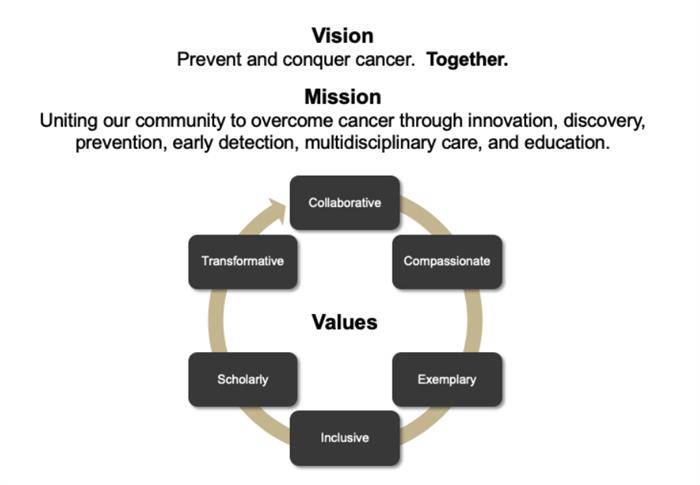Director's Message
The CU Cancer Center is the only National Cancer Institute-designated Comprehensive Cancer Center in the state of Colorado. That recognition from the NCI is an accomplishment. It signals the confidence and trust placed in us by physicians, scientists, and the national system of cancer research that expects CU Cancer Center to continue pushing forward in our mission to discover, develop and deliver tomorrow’s innovative cancer treatments.
With new honors and new partnerships, including membership in the National Comprehensive Cancer Network and the ORIEN data-sharing network, as well as the potential to offer treatments that exceed the standard-of-care through our partnership with UCHealth University of Colorado Hospital (UCH), CU Cancer Center is poised at a nexus of discovery for Colorado and beyond. And with not only new therapies, but entirely new classes of therapies now providing real hope for patients who have been without options, it has never been a more exciting time for cancer research.
As a surgeon, my mission is to honor the trust that my patients place in me. I take that trust seriously, working with my skilled team of physicians, pharmacists, nurses, social workers, and registered dietitians, among others, to respect every patient’s individual needs, goals, and beliefs as we navigate the process of diagnosis, treatment and survivorship. Now as director of the University of Colorado Cancer Center, I see a similar challenge and a similar opportunity.

Looking Forward
We used to define cancer by where it lives in the body – “lung cancer,” “breast cancer,” “prostate cancer,” etc. And the way we studied and treated the disease was compartmentalized, too, with researchers and clinicians focused on their areas of expertise, largely in isolation.
The decade of the 2010s turned this model on its head. Now we know that cancers may be better defined by their genetic changes than by where they live in the body; we know that what surrounds a tumor can be as important as the tumor itself; we know that cancer is only one part of a patient’s life; and we know that it takes interconnected teams of scientists, doctors, patients, and philanthropists to make inroads against this family of diseases.
As an organization, CU Cancer Center has the opportunity and the responsibility to change along with this new understanding. That’s why, last fall, we worked to set a new strategic vision, mission, and values. I am so proud of our results and of the team that continues to make our center one of the premier cancer clinical care, research, and education organizations in the world!

How will we conquer and overcome the suffering associated with cancer? I hope that the language of our vision, mission, and values highlights the fact that we will need to work together. We traditionally think “together” is three doctors talking, but for us this idea of togetherness goes beyond a small team of physicians, and even beyond our 300-some CU Cancer Center members working at universities and hospitals around the state, to encompass the collaborations we have with patients and their families, with government, with researchers and doctors at other institutions, with all people in Colorado communities, and with philanthropists who help to speed the development and accessibility of new treatments.
For two expressions of our organization’s collaboration, take our multidisciplinary treatment programs and investigator-initiated clinical trials.
Traditionally, cancer patients might see an internist who suspects cancer, who refers the patient to a radiologist for a biopsy. After a diagnosis is made, the patient may then be referred to a surgeon, who may want the patient to get chemotherapy first and refers to an oncologist. The oncologist may also want the patient to get radiation and refers to a radiation oncologist. Unfortunately, seeing each of these specialists sequentially can take a long time! And if these physicians never get together it can be hard to put together the big picture that leads to the best treatment plan.
The best care is when you have everyone sit down together to look at the big picture and set a course. That’s what we do in our multidisciplinary clinics – a patient spends the morning doing all needed diagnostics and then in the middle of the day, 30 or more experts from across treatment fields meet to discuss the case, and then in the afternoon the patient meets with their team to decide on the best path forward. I like to think of this big picture not as holistic medicine, but “wholistic” medicine – we look at the whole picture, including a patient’s goals, and then work together as a team to reach those goals.
Sometimes working toward those goals will require going beyond the “standard of care” for treating a cancer and into new treatments being tested in clinical trials. Traditionally, drug companies develop a new treatment and then pay for its testing. However, sometimes you can’t see these things unless you’re taking care of patients and you understand science. Our investigator-initiated clinical trials program brings our scientists together with our clinicians to generate and test promising new ideas. Of course, testing innovative ideas outside the framework of a drug company trial requires collaboration of another sort, namely with philanthropists whose generosity can help an idea gather enough momentum to earn the attention of outside funding. Philanthropy enables more clinical trials, helps us build infrastructure, and allows us to recruit and retain top talent.
In addition to working together against cancer, the language of our vision, mission, and values respects the fact that better care isn’t the only way to decrease the suffering of cancer. Most people talk about conquering cancer with treatments, but an even better way to conquer cancer is by having the patient not get cancer in the first place. Prevention is as important as treatment. Likewise, what’s the point of having all these new treatments if you can’t connect the patient with the right treatment or sequence of treatments? In other words, what use is world-class medicine if not everyone has access?
Cancer care is not one event anymore in which you come in, get a treatment, and you’re gone. Many patients are in treatment for six months or a year or more, receiving a range of treatments that keep the patient ahead of their disease. And people are living longer, better lives. In the 1970s, the overall long-term survival rate was about 50 percent; now it’s 68 percent. This means that we have more and more survivors, which is a great problem to have, but it also means that we have to make sure we take care of them, helping patients to manage the after-effects of their treatments.
Then there’s the role of education. When I go to the operating room, I’m taking care of one patient and one family at a time. But if I teach young surgeons how to do that, every day I’m helping many patients and their families. We not only have a responsibility to train the next generation of physician-scientists, but we have a vested interest in making sure our trainees have the skills to keep pushing the field forward, as the care for our families and ourselves will someday rest in their hands.
Being diagnosed with cancer is like entering a storm. You see a weather front coming and you even have a forecast. Maybe the storm doesn’t seem like it will be so bad, but then again, sometimes a process that seems simple and straightforward can take a turn overnight. And if you’re stuck in the middle of the storm without the right people and capabilities, you’re done. Here at CU Cancer Center, we have assembled the best people and cutting-edge treatment capabilities that lets us offer the best chance of survival and the best quality of life outcomes in Colorado and the world.
Together, with collaboration and compassion, we at CU Cancer Center are excited to enter this new decade with our purpose refocused on the new realities of cancer and the systems that surround it, offering every patient the best chance at the very best life, before, during, and after cancer.
Sincerely,
Richard Schulick, MD, MBA
Director, University of Colorado Cancer Center